How To Know If Your Child Is A Narcissist, Or Narcissist-To-Be
Raising a child is no easy feat. When you bring a kid into the world, there's never any guarantee about how they'll end up or what their personality will be like. No matter how hard you try to instill good behaviors and help them process things healthily, in the nature versus nurture debate, nature always plays a role.
That doesn't mean your child is destined to be a terrible person either, though. If you watch for early signs of problematic traits, you can give them the help they need to grow past them.
Something that can seriously affect development, both in childhood and adulthood, is the limiting beliefs we adopt into our regular thought cycle. To take that next step, you'll have to overcome these beliefs.
That sounds difficult, but there are tools that can help! It can start with something as small as a minutes-long audio clip designed to help you move past these beliefs. Click here to learn more today and say hello to a freer life.
The Narcissist Monolith

When you think of a narcissist, what do you picture in your mind? Maybe it's someone you've known or know currently, or maybe it's a more vague yet still evil portrait of a manipulator, hidden in shadow as they plot their next moves.
What do both of these visions have in common? Whether you know this person you envisioned or not, you likely pictured an adult.
Are adults the only age demographic capable of narcissistic patterns, though? Is a child capable of being a narcissist?
Familiar Patterns

If we're speaking technically, someone can't be fully diagnosed with narcissistic personality disorder until they're at least 18, but that doesn't mean you can't spot developing narcissistic tendencies or traits in children and teens.
That being said, narcissism does look different in adults than it does in children. In adults, there are two major types of narcissists, those being grandiose and vulnerable. These two categories present their narcissism in different manners, with the former presenting it in a more charismatic, over-the-top, yet still controlling way and the latter seeming more anxious, sensitive, and quiet in their tactics.
Harder To Pin Down

Child narcissists (or narcissists-to-be) have a lot more variation in their presentation, as their personalities are still developing, and they're still learning how they want to interact with the world.
Despite the bigger pool of potential traits, most narcissistic children can still be slotted under the grandiose or vulnerable labels, just with a bit more specificity. This is where the six child narcissist subtypes come in, even more specific categories that help people identify childhood narcissistic behaviors.
The High-Achieving Narcissist

The high-achieving child narcissist buries their vulnerabilities by being, well, high-achieving. It's not just about doing well, they have to be flawless in everything they do, they have to be the best. Their pursuit of success often takes on an almost obsessive quality.
They strive to outshine everyone else, excelling in a number of diverse areas. Whether acing exams or earning teachers' admiration, these kids stand out among the crowd. Identifying high-achieving narcissists proves tricky because their high, praise-worthy performance conceals any underlying issues or distress.
It's crucial to note that labeling someone a high-achieving narcissist hinges not on their exceptional performance alone but on understanding the driving force behind their relentless need for success. A kid doing well in school doesn't make them a budding narcissist, but a kid doing well in school in order to hide underlying issues might.
The Non-Achieving Narcissist

Non-achieving child narcissists will have impossibly high goals for themselves, hoping to garner attention for them but ultimately falling short, unknowingly setting themselves up to fail. Frustrated and wounded by their lack of success, they resort to avoidance as a coping mechanism.
Some distance themselves from their peers under the guise of not caring about other people, preferring to seem disconnected from the start over caring then failing. Alternatively, others opt for maladaptive behaviors, seeking attention through bad behavior and getting in trouble. No matter their path, they've abandoned the notion that they can attain success in a manner that garners the recognition and positive regard they crave so deeply.
The Bully Narcissist

A bully narcissist will display a real mean streak, using it to dominate others emotionally and always have the upper hand. They wield pain, fear, and even physical tactics like mockery and teasing, sometimes escalating to hazing in early adulthood.
They enjoy holding positions of authority, even social ones, such as being thought of as the "popular kid." They also tend to have likable and charismatic personas, which makes detecting their flaws challenging, especially if they conduct their bullying in secret. These types will often slip under the radar as they understand very early on that they need to put on a front while in the presence of adults.
The Daredevil Narcissist

Daredevil narcissists may just seem like rambunctious, excitable kids at first, but this energy and excitement never fade. During their school years, this grandiosity manifests in attention-seeking behavior that includes dressing in wild, unconventional ways, always challenging authority, or partaking in physically dangerous stunts.
As they grow older, these individuals may escalate to risky behaviors, spanning from substance abuse and reckless driving to sexual promiscuity. Their judgment is skewed, and they're always willing to forgo peoples' concerns, advice, or warnings in favor of getting their next thrill.
The Closet Narcissist

Closet narcissists defy the typical narcissistic image. Conscious of their vulnerability, they don't put themselves into the spotlight, instead buddying up with a socially powerful friend (in this instance, being a lackey to a popular kid, one who might also be a narcissist) and getting their fix off the residual glory that person receives.
Choosing to attach themselves to an exhibitionistic or high-achieving narcissist with considerable social standing, they tend to be compliant and adaptable. Their aim is to secure a position near the throne and ride that high as long as possible.
The Manipulative Narcissist

The manipulative narcissist is determined to have things go their way. They leverage others to achieve their objectives, completely indifferent to their feelings. Some emerge as skilled leaders who guide groups toward loftier goals, but in childhood, that scale can seem small, so it's seen as less worrisome. Think student council or club presidents.
Others exhibit more of an antisocial side. These types are more prone to stealing or lying in order to get their kicks. This could mean thieving from classmates, making up stories about their home lives, or exaggerating their social prowess outside of school.
Early Prevention

There are children who display these traits who don't grow up to become narcissists, so don't make any snap judgments too early in their development. It's just important to note these traits and maybe get them some counseling if you find they've become too intense or tread into dangerous territory.
Then, if you do notice a trait early on and get them the help they need for it early, they can learn how to better cope with the things they're feeling and not grow into adults who only become more manipulative, more desperate for attention, and more controlling with time.
Getting counseling early can also help kids deal with other things, such as low self-esteem, social struggles, or fighting against instilled limiting beliefs.
Limiting beliefs can be harder to shake later in life, but it's possible. You just need to put in some extra work. If you're lost on where that work can begin, start simple with this free audio program designed to help people overcome the limits they place on themselves. Click here to learn more today and take that first step to a new life.





